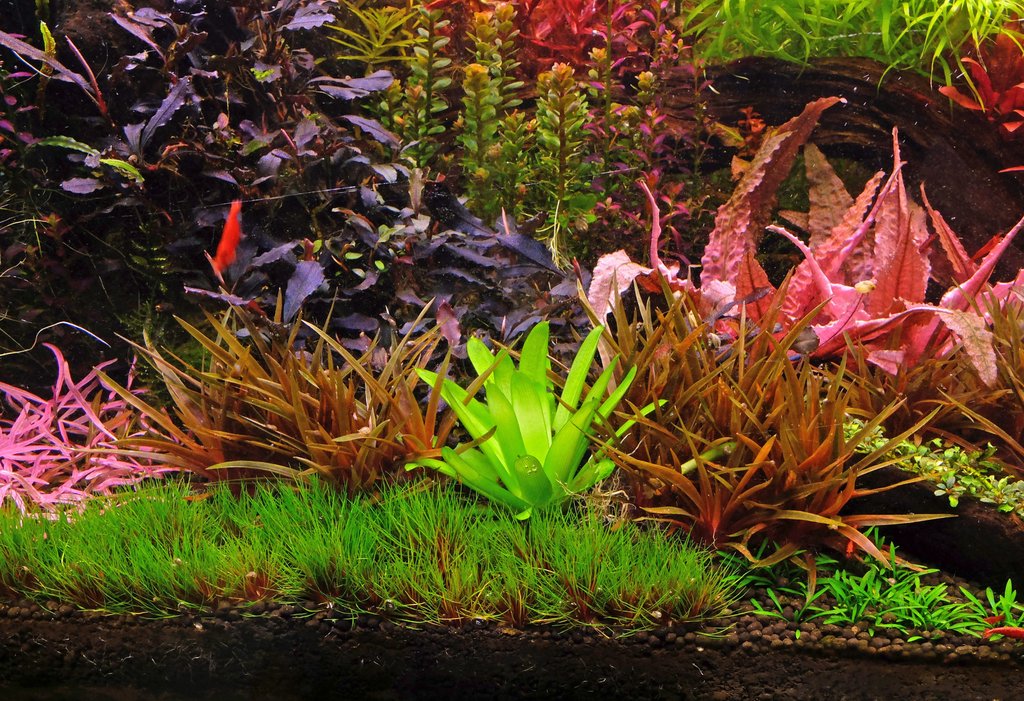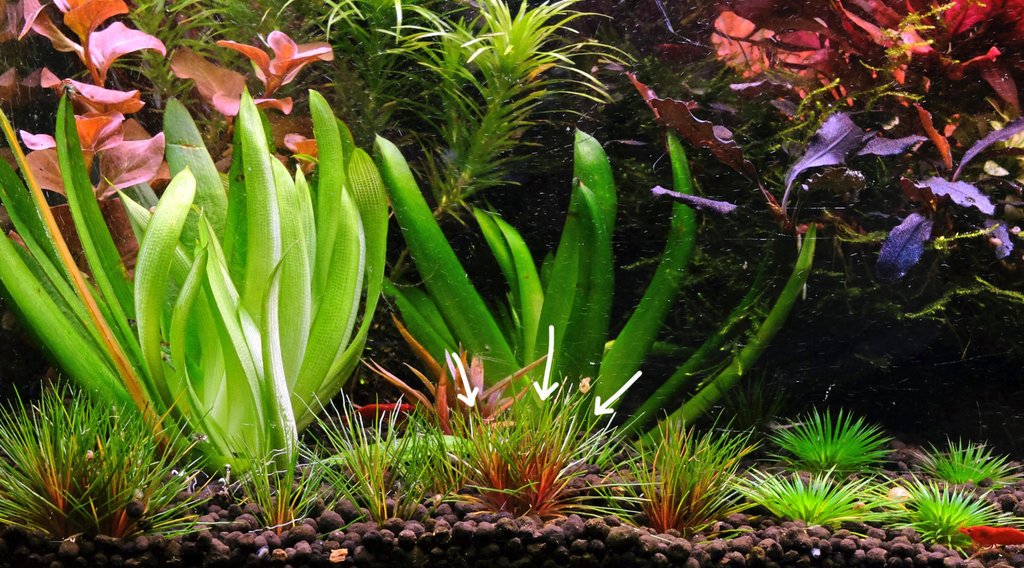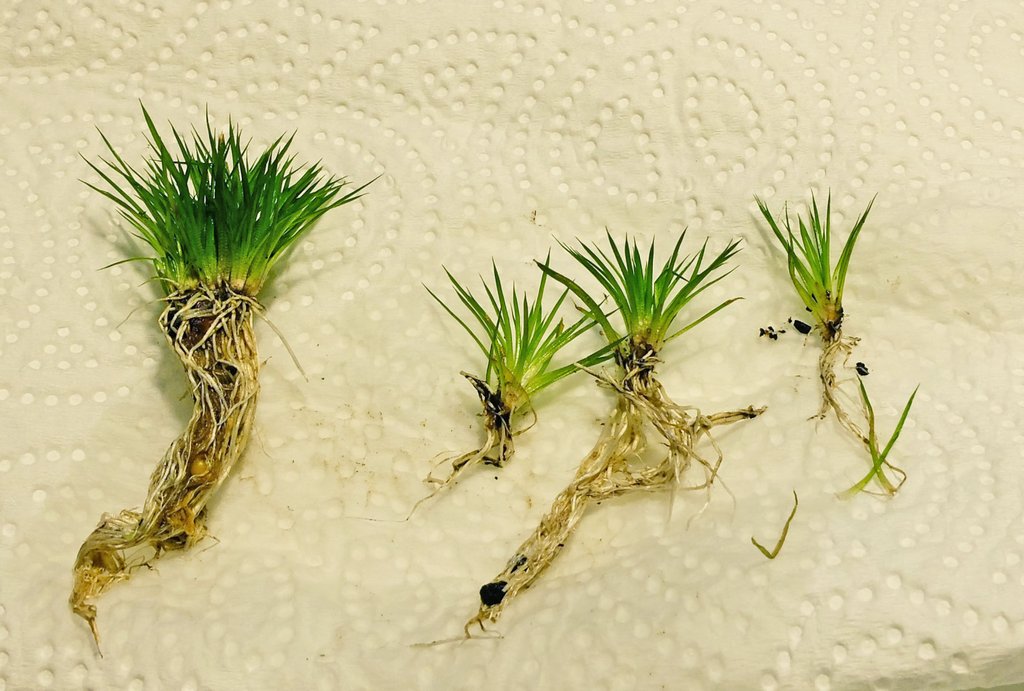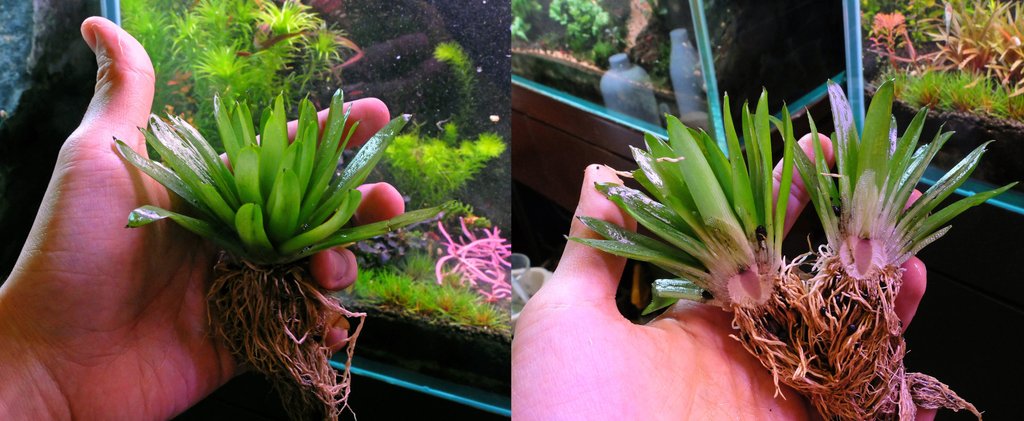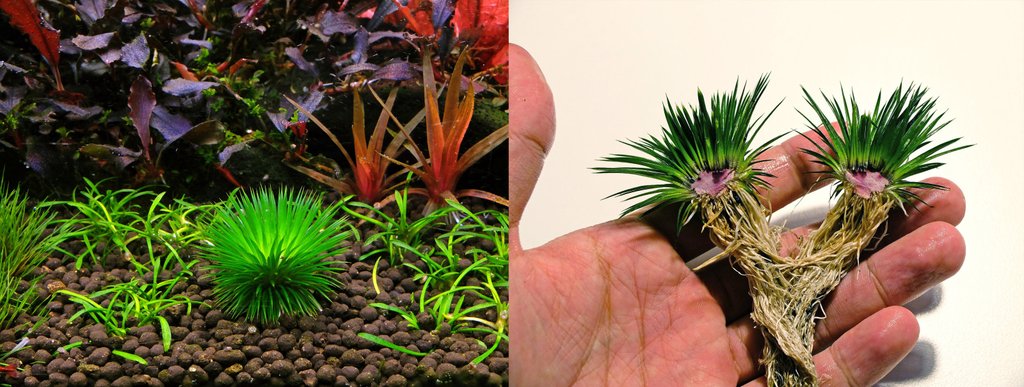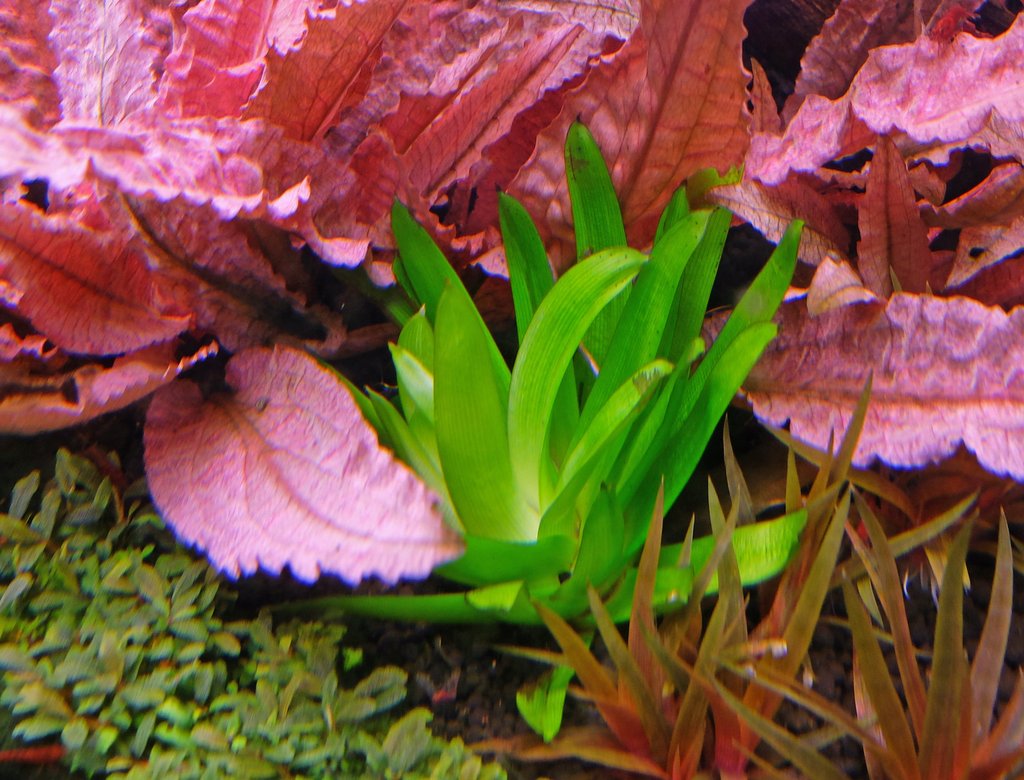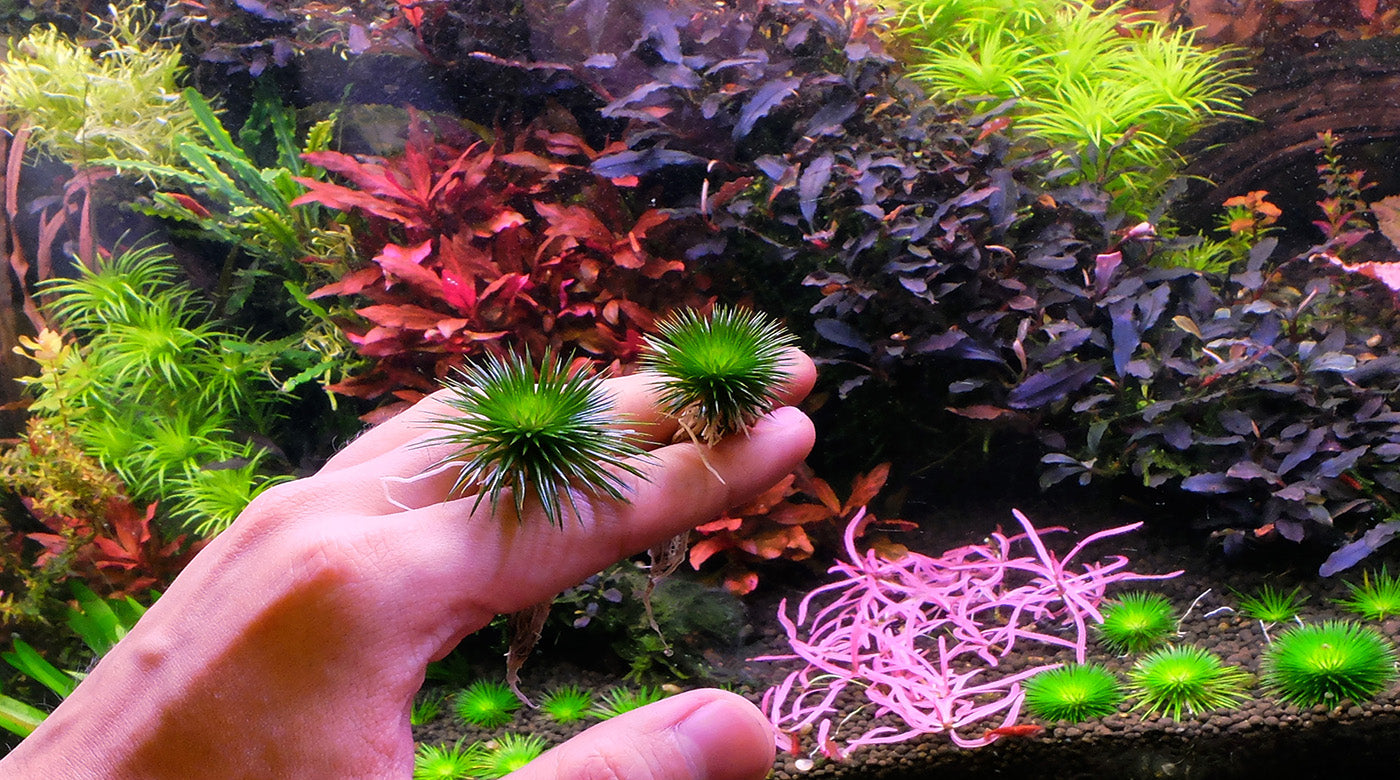
Eriocaulon species have become more common nowadays as their requirements have become better understood. Soft water (
For many Eriocaulons the roots can be longer than the leaves. (note the bright white roots)
The light green Eriocaulon cuspidatum stands out among the red Eriocaulon quinguangulare, and a foreground of Centrolepis drummondiana “Blood vomit”. All share similar growth conditions.
There are two main methods to propagate submerged grown Eriocaulons vegetatively (without going through a flowering cycle).
1. Separating crowns from naturally divided mother plant
Many species of Eriocaulon naturally produce baby plantlets/side shoots as they grow larger. In some cases, baby plantlets are produced when the plant undergoes a period of stress or instability; such as a change in growth conditions or when the plant is moved. When many baby plantlets are produced at once, it can lead to a situation of over-crowding, which leads to deterioration of the clump as a whole, so it is better to separate the plants once the daughter plants reach a suitable size.
For plants that naturally produced sideshoots, being able to identify and cleanly separate whole plants without damaging them too much is important.
Eriocaulons grow new leaves outwards from a central crown; it’ll look like all leaves grow from a single point. For plants that have plantlets, it’ll look like the leaves sprout from different points. A suitable time to divide the plant is when the crowns are clearly distinct from the main bunch. Each distinct crown can be separated as a new plant. Maintaining the integrity of each crown, being able to separate them undamaged gives higher survival rates for each plant.
Using Centrolepis drummondiana “Blood vomit” as an example (though its not an Eriocaulon, but its propagation is the same), the 3 white arrows show that the leaves originate from 3 separate points. Each is a distinct crown that can be separated into an individual plant.
Comparing a couple of Eriocaulon ratnagiricum here; plant 1 is made up of a single crown with neatly arranged leaves from a central point. Whereas plant 2 looks messy because it has leaves sprouting from multiple crowns. Plant 2 can be uprooted and divided into separate plants.
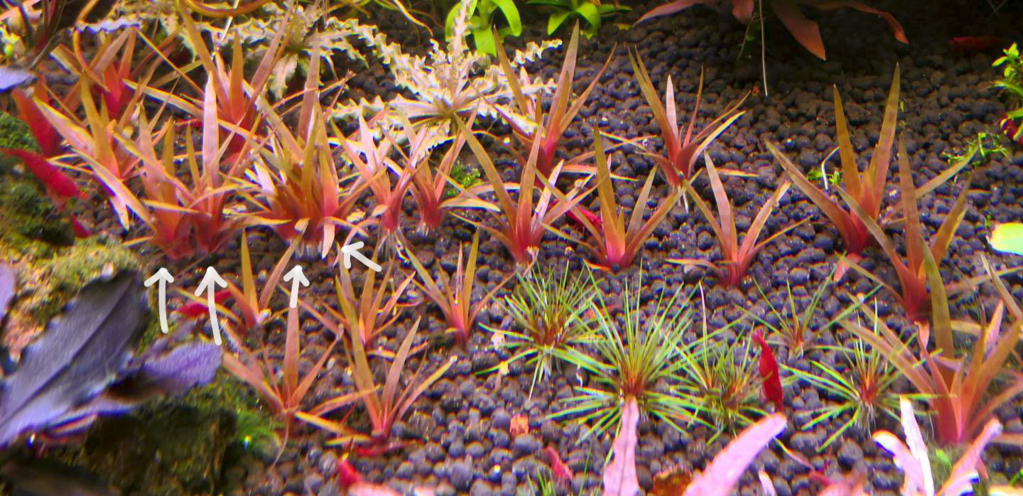
Big clusters can often be split into many plants. This clump of Eriocaulon quinquangulare was split into 10+ smaller plants.
To separate the plants, you can use tweezers to gently pull them apart. For some species that are small or delicate (such as Blood vomit), it is easier to use a blade to separate the crowns (and root zone). Cut in between the crowns down to the roots to separate them. For Eriocaulon quinguangulare, the crowns can be separated easily by hand, which is what I did for above.
Here, a multiple crown Eriocaulon ratnagiricum is split into many small individual plants. These are tiny, about 1 cm, and so require quite a bit of care. These are a bit small to pick apart with fingers, so I use tweezers to separate them for above.
Once the plants are separated, they can be planted as individual plants. Add an osmocote ball to the root clump while planting if you want accelerated growth. Remember to allocate sufficient space for each plant to grow into. Plantlets can start small but many of them have a large adult size.
2. Manual splitting of matured plant
Some species of Eriocaulons do not produce plantlets readily. Other may take a long time to naturally divide as the central clump just gets larger over time. In such cases, manually dividing the crown is the way to quickly get more plants. This process is stressful for the plant and so the plant needs to be in good shape for success. A good size to divide Eriocaulons is when they are at least half the size of a full grown adult. For Eriocaulon ratnagiricum, the full size is about 2.5 to 3 inches, so a plant that is around 1 inch plus can be divided.
Step 1 is to divide the mother plant straight down the middle with a sharp blade. Division of Eriocaulon cuspidatum and Eriocaulon ratnagiricum are shown below. Shape blade prevents one from squishing the leaves in the process. It is a straight cut down the middle. In some cases, it may be easier to cut upwards from the root area rather than down through the leaves.
After the division, both halves are planted. However, 1 of 2 things may occur. 1 – the half plant grows a single new crown from the cut point that merges with the older half of the crown; becoming a single adult plant. 2 – multiple plantlets grow out from the cut half; this often leads to overcrowding over time, so in this scenario the plant would have to be uprooted again after sometime to separate the multiple plantlets.
In the case for my Eriocaulon cuspidatum above, each half grew into single plants (like below).
Flowering and life cycles
Some Eriocaulons do not flower underwater regularly (Eriocaulon ratnagiricum, quinguangulare, cuspidatum, Shinga, Sieboldianum). Others may flower rarely with no significant impact, and continue to produce side shoots. However, certain species flower underwater as a sign of the end of their life cycle (E. polaris, cinereum). Such species should be split before their end of life cycle comes so that one can have constant supply of new baby plantlets.
When flowers appear, some species will put all energy into the growth of flowers and stop growing leaves. Pulling out the flowers will halt his process, and allow energy to channel to leaf growing again. However, for some Eriocaulon species for which the end of life cycle flowering is triggered, even pulling out flowers will not stop that from happening.
For a few Eriocaulons such as E. polaris, baby plantlets can grow from the flower stalk. This happens also for E. Cinereum if the flower stalks can breach the water line. Baby plantlets can be harvested straight from the flowers and planted.
Stable tank conditions and cooler temperatures generally discourage pre-mature flowering.

